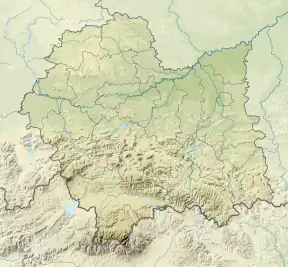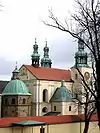| UNESCO World Heritage Site | |
|---|---|
 General view of the monastery | |
| Official name | Kalwaria Zebrzydowska: the Mannerist Architectural and Park Landscape Complex and Pilgrimage Park |
| Location | Kalwaria Zebrzydowska, Gmina Kalwaria Zebrzydowska, Wadowice County, Lesser Poland Voivodeship, Poland |
| Criteria | Cultural: (ii), (iv) |
| Reference | 905 |
| Inscription | 1999 (23rd Session) |
| Area | 380 ha (940 acres) |
| Buffer zone | 2,600 ha (6,400 acres) |
| Website | www |
| Coordinates | 49°52′N 19°40′E / 49.867°N 19.667°E |
 Location of Kalwaria Zebrzydowska Park in Lesser Poland Voivodeship  Kalwaria Zebrzydowska Park (Poland) | |
Kalwaria Zebrzydowska park is a Mannerist architectural and park landscape complex and pilgrimage park, built in the 17th century as the Counter Reformation in the late 16th century led to prosperity in the creation of calvaries in Catholic Europe.
The park, located near the town of Kalwaria Zebrzydowska, which took its name from the park, was added in 1999 to the UNESCO list of World Heritage Sites. The site is also one of Poland's official national Historic Monuments (Pomnik historii), as designated November 17, 2000 and tracked by the National Heritage Board of Poland.
History
Kalwaria Zebrzydowska was established in 1600 by Mikołaj Zebrzydowski, voivode of Kraków for Franciscan friars (custodians of the Holy Sepulchre in Jerusalem). It was modelled on the 1584 map of Jerusalem by Christian Kruik van Adrichem.[1]
Basilica of St. Mary
Basilica of St. Mary was established by Mikołaj Zebrzydowski for Bernardines. The church was designed by Giovanni Maria Bernardoni and the construction process was conducted by Paul Baudarth, an architect and goldsmith from Antwerp, between 1603–1609.[2]
Chapels
Calvary park consists 42 chapels modelled and named after the places in Jerusalem and Holy Land. There are two main paths - one devoted to Jesus Christ and the other one devoted to Holy Mary. The first has 24 chapels, the second 11 chapels, the rest are common to both of them. The most interesting are:
- Ecce Homo Chapel was built on the plan of the Greek cross between 1605-1609 by Paul Baudarth. The vault adorned with profuse stucco decorations in the style of Dutch mannerism.[3]
- Chapel of the Crucifixion is the first structure built by Mikołaj Zebrzydowski in Kalwaria and give a beginning to the whole complex.[4] It was constructed between 1600–1601.
- Heart of Mary Chapel was built on the plan of a heart in 1615 by Paul Baudarth. The chapel commemorate Jesus' encounter with Mary on the road to Calvary.[5]
- Church of the Dormition of St. Mary was built between 1615–1642 in mannerist style. It is one of the biggest objects in the park.

Images
 Basilica of St. Mary, facade
Basilica of St. Mary, facade Basilica of St. Mary, rear view
Basilica of St. Mary, rear view Interior of the basilica
Interior of the basilica Monastery
Monastery Church of the Dormition of St. Mary
Church of the Dormition of St. Mary Chapels of Crucifixion, Deposition, and Entombment of Christ
Chapels of Crucifixion, Deposition, and Entombment of Christ Chapels of Crucifixion and Disrobement of Christ
Chapels of Crucifixion and Disrobement of Christ Ecce Homo Chapel
Ecce Homo Chapel Mother's heart Chapel
Mother's heart Chapel Surroundings and one of the chapels
Surroundings and one of the chapels
See also
References
- ↑ "Kalwarie w Europie". www.niedziela.pl (in Polish). Archived from the original on 2011-07-16. Retrieved 2009-12-28.
- ↑ "Sanktuarium Kalwaryjskie". www.pascal.pl (in Polish). Archived from the original on 2012-02-24. Retrieved 2009-12-28.
- ↑ "Ratusz Pilata". www.kalwaria.eu (in Polish). Retrieved 2009-12-28.
- ↑ "Ważniejsze wydarzenia". www.kalwaria.eu (in Polish). Retrieved 2009-12-28.
- ↑ "Kaplica Serca Maryi". www.kalwaria.eu (in Polish). Retrieved 2009-12-28.
External links
- Kalwaria Zebrzydowska city website
- The Kalwaria Zebrzydowska Sanctuary (in English and Polish)